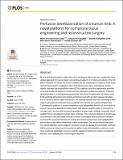| dc.contributor.author | Gerli, Mattia Francesco Maria | en_US |
| dc.contributor.author | Guyette, Jacques Paul | en_US |
| dc.contributor.author | Evangelista-Leite, Daniele | en_US |
| dc.contributor.author | Ghoshhajra, Brian Burns | en_US |
| dc.contributor.author | Ott, Harald Christian | en_US |
| dc.date.accessioned | 2018-03-20T16:00:11Z | |
| dc.date.issued | 2018 | en_US |
| dc.identifier.citation | Gerli, Mattia Francesco Maria, Jacques Paul Guyette, Daniele Evangelista-Leite, Brian Burns Ghoshhajra, and Harald Christian Ott. 2018. “Perfusion decellularization of a human limb: A novel platform for composite tissue engineering and reconstructive surgery.” PLoS ONE 13 (1): e0191497. doi:10.1371/journal.pone.0191497. http://dx.doi.org/10.1371/journal.pone.0191497. | en |
| dc.identifier.issn | | en |
| dc.identifier.uri | http://nrs.harvard.edu/urn-3:HUL.InstRepos:35014806 | |
| dc.description.abstract | Muscle and fasciocutaneous flaps taken from autologous donor sites are currently the most utilized approach for trauma repair, accounting annually for 4.5 million procedures in the US alone. However, the donor tissue size is limited and the complications related to these surgical techniques lead to morbidities, often involving the donor sites. Alternatively, recent reports indicated that extracellular matrix (ECM) scaffolds boost the regenerative potential of the injured site, as shown in a small cohort of volumetric muscle loss patients. Perfusion decellularization is a bioengineering technology that allows the generation of clinical-scale ECM scaffolds with preserved complex architecture and with an intact vascular template, from a variety of donor organs and tissues. We recently reported that this technology is amenable to generate full composite tissue scaffolds from rat and non-human primate limbs. Translating this platform to human extremities could substantially benefit soft tissue and volumetric muscle loss patients providing tissue- and species-specific grafts. In this proof-of-concept study, we show the successful generation a large-scale, acellular composite tissue scaffold from a full cadaveric human upper extremity. This construct retained its morphological architecture and perfusable vascular conduits. Histological and biochemical validation confirmed the successful removal of nuclear and cellular components, and highlighted the preservation of the native extracellular matrix components. Our results indicate that perfusion decellularization can be applied to produce human composite tissue acellular scaffolds. With its preserved structure and vascular template, these biocompatible constructs, could have significant advantages over the currently implanted matrices by means of nutrient distribution, size-scalability and immunological response. | en |
| dc.language.iso | en_US | en |
| dc.publisher | Public Library of Science | en |
| dc.relation.isversionof | doi:10.1371/journal.pone.0191497 | en |
| dc.relation.hasversion | http://www.ncbi.nlm.nih.gov/pmc/articles/PMC5774802/pdf/ | en |
| dash.license | LAA | en_US |
| dc.subject | Biology and Life Sciences | en |
| dc.subject | Cell Biology | en |
| dc.subject | Cellular Structures and Organelles | en |
| dc.subject | Extracellular Matrix | en |
| dc.subject | Anatomy | en |
| dc.subject | Biological Tissue | en |
| dc.subject | Muscle Tissue | en |
| dc.subject | Medicine and Health Sciences | en |
| dc.subject | Surgical and Invasive Medical Procedures | en |
| dc.subject | Biopsy | en |
| dc.subject | Biochemistry | en |
| dc.subject | Proteins | en |
| dc.subject | Collagens | en |
| dc.subject | Physical Sciences | en |
| dc.subject | Materials Science | en |
| dc.subject | Materials by Attribute | en |
| dc.subject | Surfactants | en |
| dc.subject | Detergents | en |
| dc.subject | Plastic Surgery and Reconstructive Techniques | en |
| dc.subject | Imaging Techniques | en |
| dc.subject | Neuroimaging | en |
| dc.subject | Computed Axial Tomography | en |
| dc.subject | Neuroscience | en |
| dc.subject | Diagnostic Medicine | en |
| dc.subject | Diagnostic Radiology | en |
| dc.subject | Tomography | en |
| dc.subject | Radiology and Imaging | en |
| dc.subject | Specimen Preparation and Treatment | en |
| dc.subject | Staining | en |
| dc.subject | Nuclear Staining | en |
| dc.title | Perfusion decellularization of a human limb: A novel platform for composite tissue engineering and reconstructive surgery | en |
| dc.type | Journal Article | en_US |
| dc.description.version | Version of Record | en |
| dc.relation.journal | PLoS ONE | en |
| dash.depositing.author | Ghoshhajra, Brian Burns | en_US |
| dc.date.available | 2018-03-20T16:00:11Z | |
| dc.identifier.doi | 10.1371/journal.pone.0191497 | * |
| dash.contributor.affiliated | Ott, Harald | |
| dash.contributor.affiliated | Ghoshhajra, Brian | |


